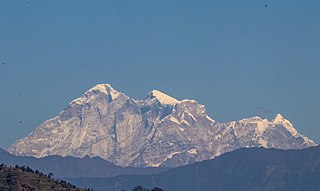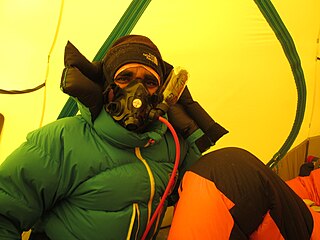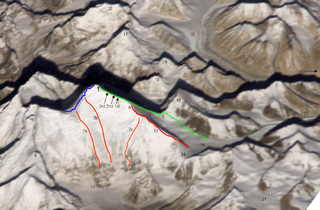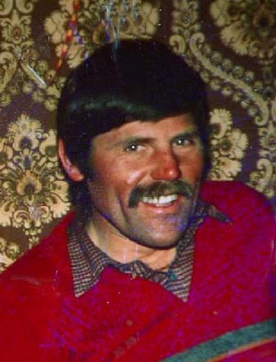Related Research Articles

Kangchenjunga, also spelled Kanchenjunga, Kanchanjanghā and Khangchendzonga, is the third-highest mountain in the world. Its summit lies at 8,586 m (28,169 ft) in a section of the Himalayas, the Kangchenjunga Himal, which is bounded in the west by the Tamur River, in the north by the Lhonak River and Jongsang La, and in the east by the Teesta River. It lies in the border region between Koshi Province of Nepal and Sikkim state of India, with the two peaks West and Kangbachen in Nepal's Taplejung District and the other three peaks Main, Central and South directly on the border.

Lhotse is the fourth-highest mountain on Earth, after Mount Everest, K2, and Kangchenjunga. At an elevation of 8,516 metres (27,940 ft) above sea level, the main summit is on the border between Tibet Autonomous Region of China and the Khumbu region of Nepal.

Cho Oyu is the sixth-highest mountain in the world at 8,188 metres (26,864 ft) above sea level. Cho Oyu means "Turquoise Goddess" in Tibetan. The mountain is the westernmost major peak of the Khumbu sub-section of the Mahalangur Himalaya 20 km west of Mount Everest. The mountain stands on the China–Nepal border, between the Tibet Autonomous Region and Koshi Province.

Dhaulagiri, located in Nepal, is the seventh highest mountain in the world at 8,167 metres (26,795 ft) above sea level, and the highest mountain within the borders of a single country. It was first climbed on 13 May 1960 by a Swiss-Austrian-Nepali expedition. Annapurna I is 34 km (21 mi) east of Dhaulagiri. The Kali Gandaki River flows between the two in the Kaligandaki Gorge, said to be the world's deepest. The town of Pokhara is south of the Annapurnas, an important regional center and the gateway for climbers and trekkers visiting both ranges as well as a tourist destination in its own right.

Shishapangma, or Shishasbangma or Xixiabangma, is the 14th-highest mountain in the world, at 8,027 metres (26,335 ft) above sea level. It is located entirely within Tibet. In 1964, it became the final eight-thousander to be climbed.

Anatoli Nikolaevich Boukreev was a Soviet and Kazakh mountaineer who made ascents of 10 of the 14 eight-thousander peaks—those above 8,000 m (26,247 ft)—without supplemental oxygen. From 1989 through 1997, he made 18 successful ascents of peaks above 8,000 m.

Gaurishankar, a mountain in the Nepal Himalayas, is the second highest peak of the Rolwaling Himal, behind Melungtse (7,181 m). The name comes from the Hindu goddess Gauri, a manifestation of Parvati, and her consort Shankar, denoting the sacred regard it is afforded by the people of Nepal. The Sherpas name the mountain as Jomo Tseringma. The Nepal Standard Time (GMT+05:45) is based on the meridian of this mountain peak.
The Oxford University Mountaineering Club (OUMC) was founded in 1909 by Arnold Lunn, then a Balliol undergraduate; he did not earn a degree.
Tim Macartney-Snape is an Australian mountaineer and author. On 3 October 1984 Macartney-Snape and Greg Mortimer were the first Australians to reach the summit of Mount Everest. They reached the summit, climbing without supplementary oxygen, via a new route on the North Face. In 1990, Macartney-Snape became the first person to walk and climb from sea level to the top of Mount Everest. Macartney-Snape is also the co-founder of the Sea to Summit range of outdoor and adventure gear and accessories, a guide for adventure travel company World Expeditions and a founding director and patron of the World Transformation Movement.

The Kangshung Face or East Face is the eastern-facing side of Mount Everest, one of the Tibetan sides of the mountain. It is 3,350 metres (11,000 ft) from its base on the Kangshung Glacier to the summit. It is a broad face, topped on the right by the upper Northeast Ridge, and on the left by the Southeast Ridge and the South Col. Most of the upper part of the face is composed of hanging glaciers, while the lower part consists of steep rock buttresses with couloirs between them. The steep southern third of the Kangshung Face also comprises the Northeastern Face of Lhotse; this section may be considered a separate face altogether following the division of the South "Neverest" Buttress up to the South Col. It is considered a dangerous route of ascent, compared to the standard North Col and South Col routes, and it is the most remote face of the mountain, with a longer approach.

Louis French Reichardt is a noted American neuroscientist and mountaineer, the first American to summit both Everest and K2. He was also director of the Simons Foundation Autism Research Initiative, the largest non-federal supporter of scientific research into autism spectrum disorders and is an emeritus professor of physiology and biochemistry/biophysics at UCSF, where he studied neuroscience. The character of Harold Jameson, U.C.S.F. biophysicist and mountaineer in the film K2, is based on Reichardt, though the events of his actual 1978 K2 attempt with Jim Wickwire bear little resemblance to the plot of the film.

Nicholas John Estcourt was a British mountaineer and alpinist who was killed in an avalanche on the West Ridge of K2.
Victor Saunders is a British climber, mountain guide and author. He has summitted Mount Everest six times, and has climbed all the Seven Summits. His first book, Elusive Summits, won the Boardman Tasker Prize for Mountain Literature in 1991.

Expedition climbing, is a type of mountaineering that uses a series of well-stocked camps on the mountain leading to the summit, that are supplied by teams of mountain porters. In addition, expedition climbing can also employ multiple 'climbing teams' to work on the climbing route—not all of whom are expected to make the summit—and allows the use of supports such as fixed ropes, aluminum ladders, supplementary oxygen, and sherpa climbers. By its nature, expedition climbing often requires weeks to complete a given climbing route, and months of pre-planning given the greater scale of people and equipment that need to be coordinated for the climb.

The Three Pinnacles are a formation of steep rocks along the northeast ridge on Mount Everest. They were one of the longest unsolved challenges in high-level mountaineering, but have now been successfully climbed.

The 1921 British Mount Everest reconnaissance expedition set off to explore how it might be possible to get to the vicinity of Mount Everest, to reconnoitre possible routes for ascending the mountain, and – if possible – make the first ascent of the highest mountain in the world. At that time Nepal was closed to foreigners, so any approach had to be from the north, through Tibet. A feasible route was discovered from the east up the Kharta Glacier and then crossing the Lhakpa La pass north east of Everest. It was then necessary to descend to the East Rongbuk Glacier before climbing again to Everest's North Col. However, although the North Col was reached, it was not possible to climb further before the expedition had to withdraw.

Kharta is a region in Tibet lying to the east of Mount Everest and centred on the Kharta valley and Kama valley. The 40-kilometre (25 mi) Kharta valley starts at the col at Lhakpa La at the head of the Kharta Glacier from which the Kharta Chu river flows east to join the Phung Chu just beyond Khata village. Nearby to the south, the Kama valley starts at the Kangshung Glacier at the foot of Everest's Kangshung Face, and the Kama Chu flows southeast to the Phung Chu. The 1921 British Mount Everest reconnaissance expedition discovered Kharta when reconnoitring ways to climb Mount Everest and managed to reach the North Col via the Lhakpa La. Since that time Kharta has not been used as a way to approach the summit of Everest but the two valleys have become a popular area for trekking.

Debabrata Mukherjee is an Indian mountaineer and explorer from West Bengal. He was the oldest, first civilian Indian to climb Mount Everest from the North Col. He is also the first person to cross Chaukhamba Col from Badrinath to reach Gangotri.

Franz Oppurg was an Austrian mountain climber. Having climbed from a young age, he became a mountain guide and rescuer, and did a number of first ascents in the winter of mountains in his native Karwendel. He was also the first climber to achieve a solo ascent of Mount Everest.
Karl Maria Herrligkoffer was a German medical doctor, who from 1953 and 1986, organized and directed numerous German and Austrian mountaineering expeditions including 13 expeditions to five of the world's highest peaks in the Himalayas and the Karakoram. There were some notable successes on these expeditions including the first ascent of Nanga Parbat (8126m), and also the second and third ascent of that mountain, the successful ascent of Everest (8849m) by 15 people from one expedition, the first ascent of the South Ridge of K2 (8611m), the first attempt on Broad Peak (8051m), and the first ascent of about 35 peaks during two expeditions to east Greenland.
References
- ↑ Unsworth, Walt (2000). Everest, The Mountaineering History. Seattle, WA, USA: Mountaineers Books. p. 503. ISBN 978-0-89886-670-4.
- ↑ Venables, Stephen. "Stephen Venables". Linked in. Retrieved 27 May 2023.
- ↑ Venables, Stephen. Ollie: The True Story of a Brief and Courageous Life, Hutchinson, 2006, ISBN 009947879X
- ↑ Awards at banffcentre.ca